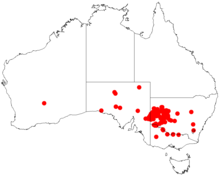
Acacia pycnantha, most commonly known as the golden wattle, is a tree of the family Fabaceae native to southeastern Australia. It grows to a height of 8 m (26 ft) and has phyllodes instead of true leaves. Sickle-shaped, these are between 9 and 15 cm long, and 1–3.5 cm wide. The profuse fragrant, golden flowers appear in late winter and spring, followed by long seed pods. Plants are cross-pollinated by several species of honeyeater and thornbill, which visit nectaries on the phyllodes and brush against flowers, transferring pollen between them. An understorey plant in eucalyptus forest, it is found from southern New South Wales and the Australian Capital Territory, through Victoria and into southeastern South Australia.
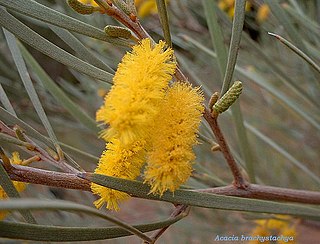
Acacia brachystachya, commonly known as umbrella mulga, turpentine mulga or false bowgada, is a shrub in the family Fabaceae. The species occurs in mulga and heath communities on sandhills and rocky ridges in all mainland states of Australia, except Victoria.

Acacia grasbyi, commonly known as miniritchie, is a shrub or tree in the family Fabaceae that is endemic to parts of arid western and central Australia.

Acacia implexa, commonly known as lightwood or hickory wattle, is a fast-growing Australian tree, the timber of which is used for furniture making. The wood is prized for its finish and strength. The foliage was used to make pulp and dye cloth.
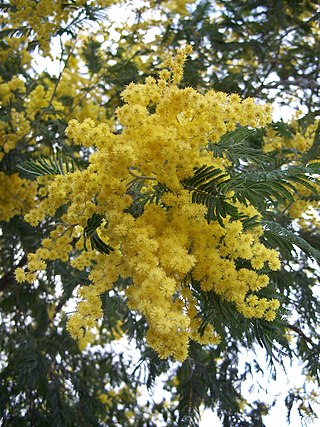
Acacia dealbata, the silver wattle, blue wattle or mimosa, is a species of flowering plant in the legume family Fabaceae, native to southeastern Australia in New South Wales, Victoria, Tasmania, and the Australian Capital Territory, and widely introduced in Mediterranean, warm temperate, and highland tropical landscapes.

Acacia salicina is a thornless species of Acacia tree native to Australia.

Acacia decurrens, commonly known as black wattle or early green wattle, is a perennial tree or shrub native to eastern New South Wales, including Sydney, the Greater Blue Mountains Area, the Hunter Region, and south west to the Australian Capital Territory. It grows to a height of 2–15 m (7–50 ft) and it flowers from July to September.

Acacia falcata, commonly known as sickle wattle and by other vernacular names including sally, is a perennial shrub or tree native to eastern Australia, which reaches five metres in height and has cream flowers in early winter. It gets its common and scientific name for its sickle-shaped leaves. Hardy and adaptable to cultivation, it is used in regeneration of bushland.

Acacia penninervis, commonly known as mountain hickory wattle, or blackwood, is a perennial shrub or tree is an Acacia belonging to subgenus Phyllodineae, that is native to eastern Australia.

Eucalyptus macrorhyncha, commonly known as the red stringybark, is a species of medium-sized tree that is endemic to eastern Australia. It has rough, stringy, grey to brown bark, lance-shaped adult leaves, flower buds in groups of between seven and eleven, white flowers and hemispherical fruit.

Eucalyptus cinerea, commonly known as the Argyle apple, mealy stringbark or silver dollar tree, is a species of small- to medium-sized tree that is endemic to south-eastern Australia. It has rough, fibrous bark on the trunk and branches, usually only juvenile, glaucous, egg-shaped evergreen leaves, flower buds in groups of three, white flowers and conical to bell-shaped fruit.
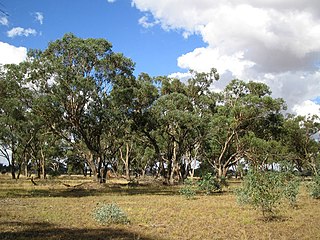
Eucalyptus microcarpa, commonly known as grey box, is a species of tree that is endemic to southeastern continental Australia. It has rough, fibrous or flaky bark on the trunk, smooth whitish bark above, lance-shaped adult leaves, flower buds in groups of between seven and eleven, white flowers and oval, cylindrical or urn-shaped fruit.

Callitris endlicheri, commonly known as the black cypress pine, is a species of conifer in the family Cupressaceae. It is found only in Australia, occurring in Queensland, New South Wales, the Australian Capital Territory, and Victoria.
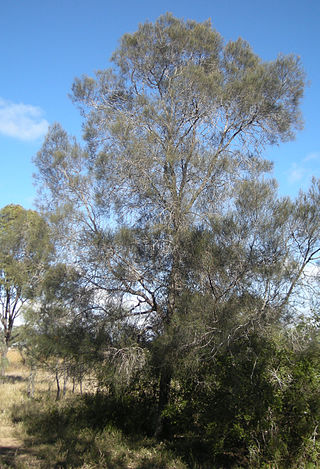
Allocasuarina luehmannii is a species of ironwood tree native to Australia and its wood is the hardest commercially available as measured by the Janka Hardness Scale.

Eucalyptus albens, known as the white box, is a common tree of the western slopes and plains of New South Wales and adjacent areas in Queensland and Victoria. It has rough, fibrous bark on the base of its trunk and smooth, white bark above. The leaves are lance-shaped and groups of seven spindle-shaped flower buds are arranged in leaf axils or on the ends of the branches. White flowers are mostly present between August and February and the fruit are barrel-shaped to urn-shaped.

Acacia prominens is a shrub or tree in the genus Acacia native to New South Wales, Australia.
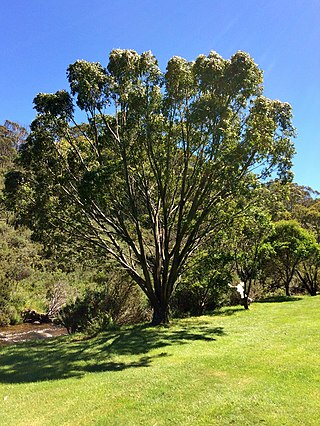
Eucalyptus stellulata, commonly known as black sallee or black sally, is a species of small tree or a mallee that is endemic to higher altitude regions of south-eastern Australia. it has rough bark on the lower part of the trunk smooth greenish bark above, lance-shaped to elliptical leaves, flower buds in group of between nine and fifteen, white flowers and cup-shaped or shortened spherical fruit.

Casuarina cristata, commonly known as belah or muurrgu, is a species of flowering plant in the family Casuarinaceae and is endemic to inland eastern Australia. It is a tree with fissured or scaly bark, sometimes drooping branchlets, the leaves reduced to scales in whorls of 8 to 12, the fruit 13–18 mm (0.51–0.71 in) long containing winged seeds (samaras) 6.0–10.5 mm (0.24–0.41 in) long.

Acacia cana, or commonly named as boree or the cabbage-tree wattle or broad-leaved nealie, is part of the family Fabaceae and sub-family Mimosoideae. It is a dense shrub- tree that can grow to 6 metres (20 ft) high and is a perennial plant meaning it has long life span and doesn’t necessary produce a high amount of seed. The cabbage-tree wattle heavily flowers from August till October and relies on animals and insects for pollination and dispersal of seeds. This least concern acacia species is found in the western plains of New South Wales and Central Queensland the habitats of these areas are found to be sandy soils and gibber plains.

Acacia sibirica, commonly known as bastard mulga or false witchetty bush, is a tree or shrub belonging to the genus Acacia and the subgenus Juliflorae. It is native to arid areas of Australia.
